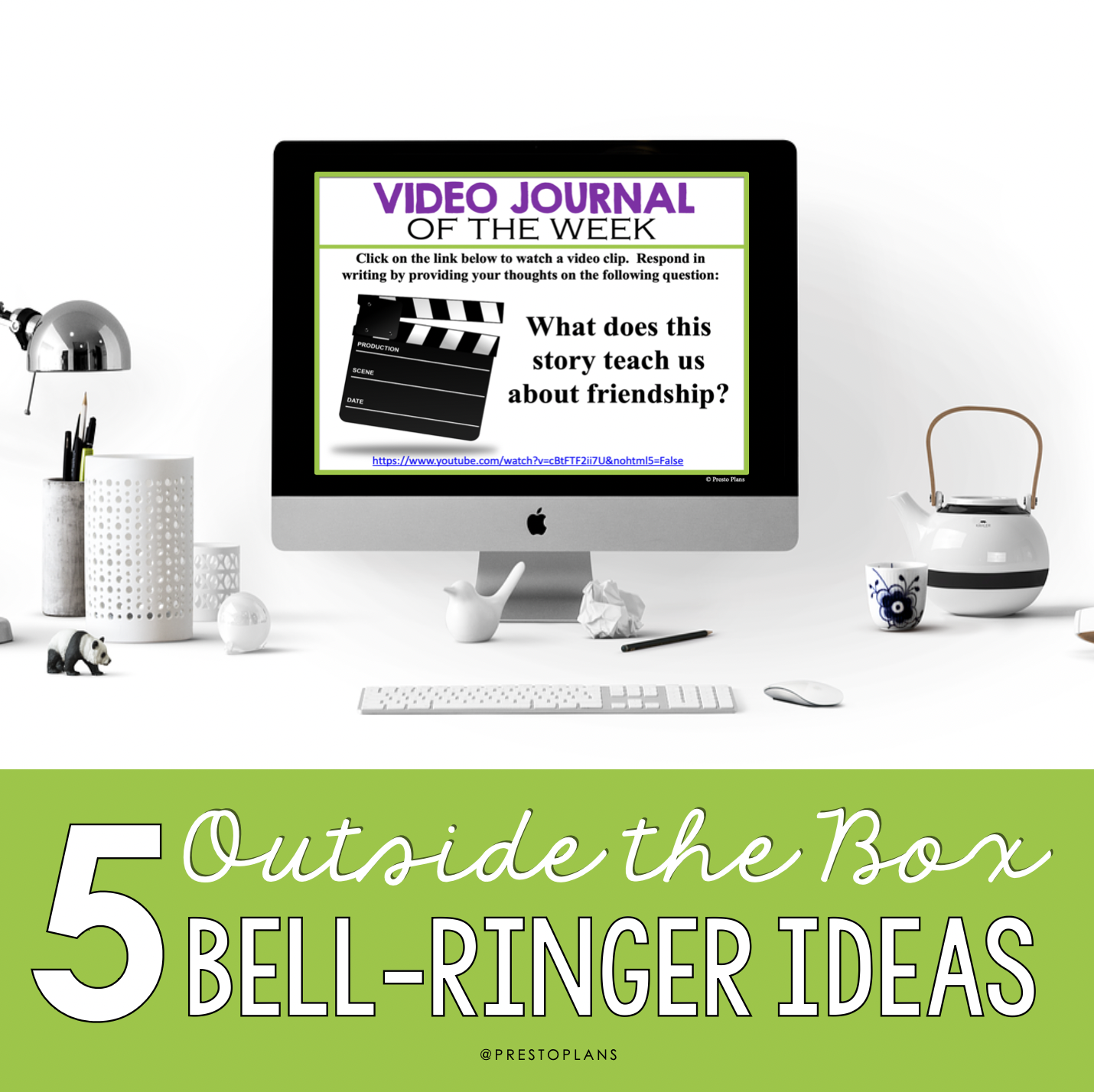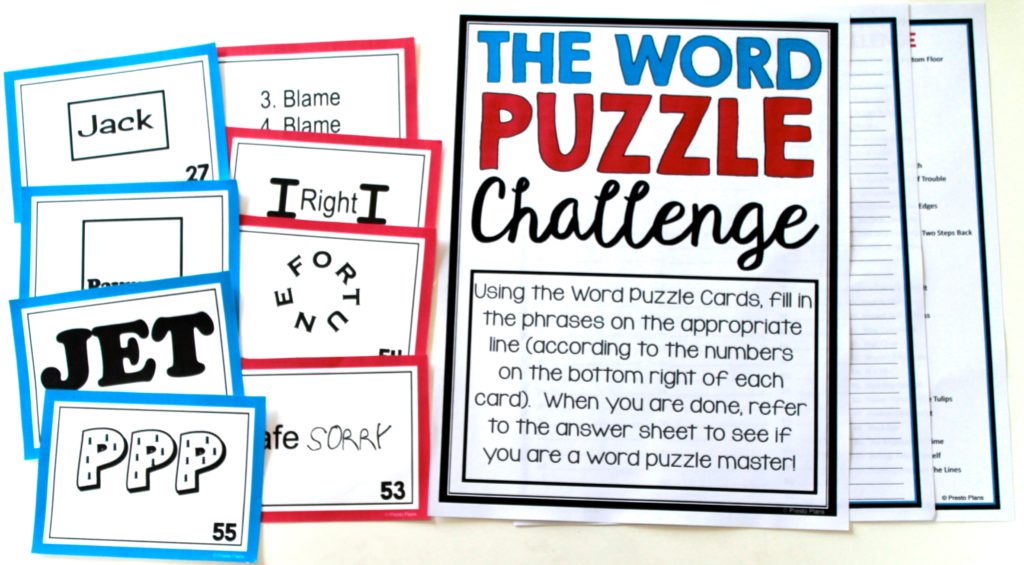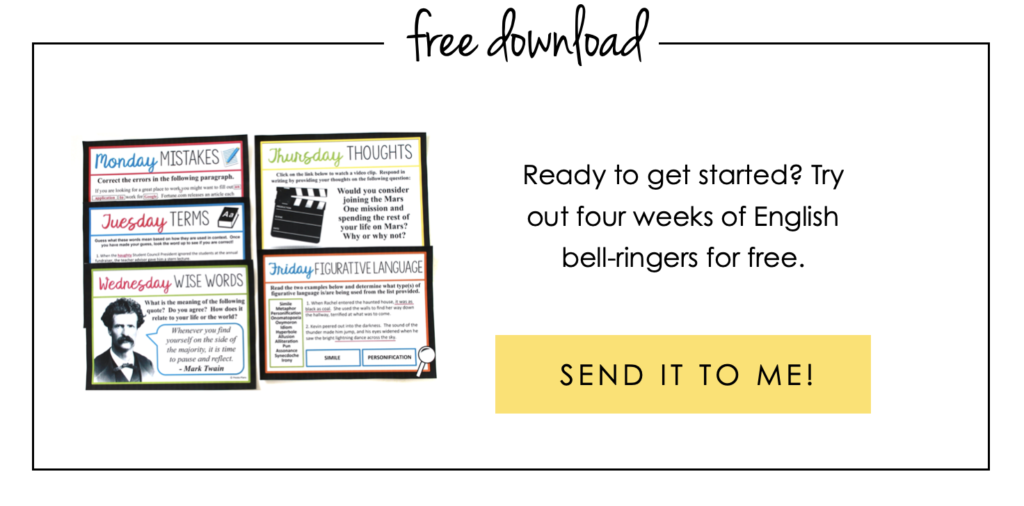PRESTO PLANS
Sent straight to your inbox
CLICK HERE TO ACCESS
Sign up to receive 10 ready-to-use ELA resources your students will love!
10 FREE ELA RESOURCES

5 Outside-the-Box Bell-Ringer Ideas for ELA
Have you ever used bell-ringers in your ELA classroom? If so, you know how game-changing these can be in establishing a routine for your students. Not only do they calm the class chaos and set the tone right away, but they also help your students to develop important ELA skills and hit standards. Bell-ringers do all of this while also buying you an extra 5-10 minutes at the start of each class.
Sometimes referred to as “warm-ups” or “do-nows,” bell-ringers are activities that students do at the beginning of class (right when the bell rings). Although they are often used to teach things like grammar, figurative language, word choice, etc., bell-ringers can be used in a variety of creative and unique ways.
Here are 5 outside-the-box bell-ringer ideas that you can bring to your ELA classroom right away.
1. Video Journals
The idea to use videos as bell-ringers arose from a teachable moment in my grade 10 ELA classroom. After the bell rang, a student sauntered into the classroom, taking a couple of bites from a chocolate bar before throwing the rest into the trash. I know what you’re thinking because I was thinking the same thing: Who throws out a perfectly good chocolate bar?
After learning that there was nothing wrong with the chocolate bar and that the student just threw it out because he didn’t want it, I was reminded of a video I had seen about cacao bean farmers from Ivory Coast who had never tasted chocolate. I thought this would be the perfect moment to show this video and see what students thought. What happened next was game-changing for me.
The class, which usually took a while to settle down, settled immediately, giving their full attention to the video. Then, I asked them to write a response to the video, and for the ten minutes that I gave them to complete their responses, everyone was writing silently. The discussion that ensued was meaningful and productive. It was definitely a lightbulb moment!
After this, I started collecting short videos that were thought-provoking and developed related prompts for students to ponder. I started using video journals once a week as a writing prompt, and you can do the same. Video journals are not only great for classroom management and engaging reluctant writers, but they are also extremely easy to do! There’s plenty of great video content out there to use. You can even find videos that connect to themes in your class texts and incorporate video journals seamlessly into your curriculum.
I’m so obsessed with video journals that I included them in all four sets of my bell-ringers.
2. Friendly Debate
Like bell-ringers, debates are a great tool for the ELA classroom. Not only do they help students develop their critical thinking, persuasive, and speaking skills, but they’re also great for teaching students about the importance of using evidence to support claims. You can easily use bell-ringers to lead friendly debates in your class. Nothing gets students engaged quite like a good old-fashioned debate, after all!
However, not all students are quite so keen to defend their opinions out loud in front of the class. Outside of general class discussion and perhaps a standalone unit on debating if you have one, students don’t get many opportunities to develop these skills. Debate bell-ringers are a less formal way of practicing these important skills, which will be especially useful for your more shy and reluctant students.
My favorite way to incorporate debates through bell-ringers is with “What if“ or “What would you do?“ prompts. Discussion cards like these prompt students to imagine how they would respond to an ethical dilemma in a low-stakes way.
Write hypothetical questions like: “You are waiting at a red light at 4:00 am, and there isn’t a car in sight. Would you run the light?” or “What if humans could fly?” on discussion cards, and even your shiest and most reluctant students will have something to say.
3. Photo Writing Prompts
Just like you can use videos as prompts for your bell-ringers, you can also use pictures to get your ELA students putting pencil to paper at the start of each class! There are plenty of funny images out there that work great as photo writing prompts, and you can incorporate these into your classroom routine in a couple of different ways.
One way you can do this is to get students to look at a new picture and do a timed writing response for 10 minutes. Each time you do this, students can start from a new picture and will have a finished product each class. Of course, with this approach, students will need to write quickly—and there’s a benefit to this, for sure. It creates urgency and encourages students to write whatever strikes!
What’s great about the photo writing prompts is that you will have a bank of student writing quickly on hand that you can use for students to practice and improve ELA skills you’re working on in class. Let’s say you’re working on word choice, for example (or any other ELA skill). You can have students refer back to their completed photo writing responses and get them to improve their writing, applying what they’ve learned.
Another option to using the image as a single-day writing prompt is to get students to work with the same image over the course of one week and assign a new task each day, with students completing a good copy on the last day. You might get students to work on a rough draft on Monday and Tuesday, for example. On Wednesday, you could get them to focus on word choice, and so on, leading towards having a more polished end product by Friday.
4. Group Brainstorm
Group brainstorming is another idea for outside-the-box bell-ringers that you can bring to your ELA classroom. To do this in your class, you can start by putting students into groups of 3 or 4. Give them an interesting topic, and then, get them to brainstorm, with their groups, as many words as possible that relate to that topic for 3 minutes.
You might choose a topic like “Things that have wheels,” for example. This one works well because, although it seems simple (our minds immediately go to cars, trucks, bicycles, etc.), we quickly run out of obvious answers. Then, students must think outside the box and come up with more creative associations. A watch, for example, has wheels, and so does a kitchen drawer!
You can even make this into a friendly competition between groups. Get students to volunteer to share their answers. If another group has the same answer, all the groups have to cross it out. Give one point for answers that no other team has. Not only is this an extremely fun activity, but it will also encourage your students to push past boundaries and use lateral thinking to come up with non-obvious answers.
Here are a few more topics you can use with your students:
- Clothes you wear in the winter
- What a dog might say
- Things that can grow
- Things that are orange
- Things that you need to take on vacation
5. Word Puzzles
If you’re simply looking for a fun activity to get students’ brains warmed up at the beginning of class, you can use word puzzles as your daily bell-ringers. You might get students to do anagrams (write a word formed by rearranging the letters of another word) or word circles, where students need to use only the letters in three circles (one at a time) to write three related words beneath.
My favorite brain teaser activity to do with students is a word puzzle challenge where students need to guess a phrase based on riddle-like representations of it. For example, you might have the word “Fortune” written in a circle, and students need to use their problem-solving skills to determine the phrase, which is “Wheel of Fortune” or the word “Jack” written inside of a rectangle, and the answer is “Jack in a box.” It’s a fun way to jumpstart critical thinking and improve focus at the beginning of class.

There you have it! I hope you found these ideas for outside-the-box ELA bell-ringers helpful. Check out the ready-to-use ELA resources mentioned in the post below.

Search the blog for what you are teaching
GIVEAWAYS
sent straight to your inbox!











share this post